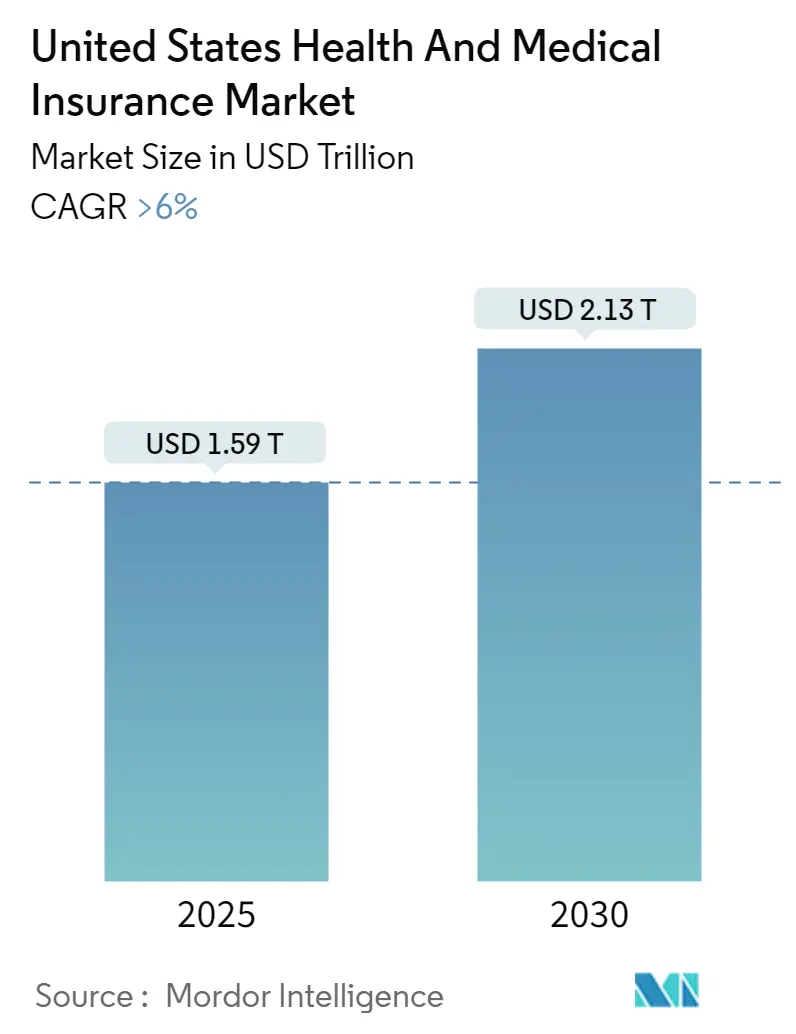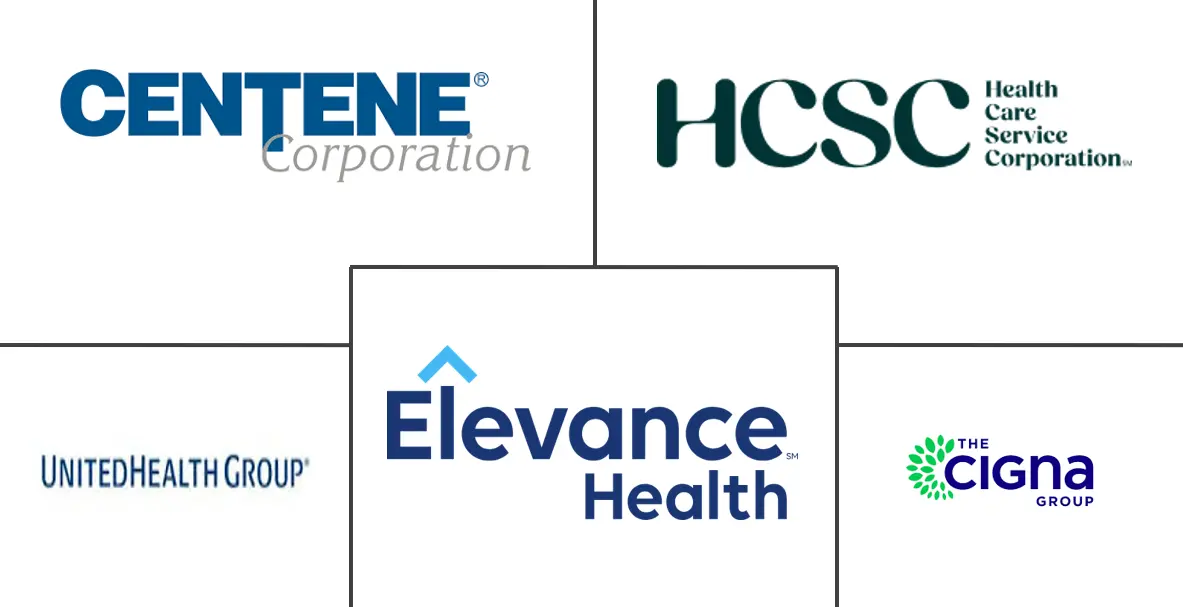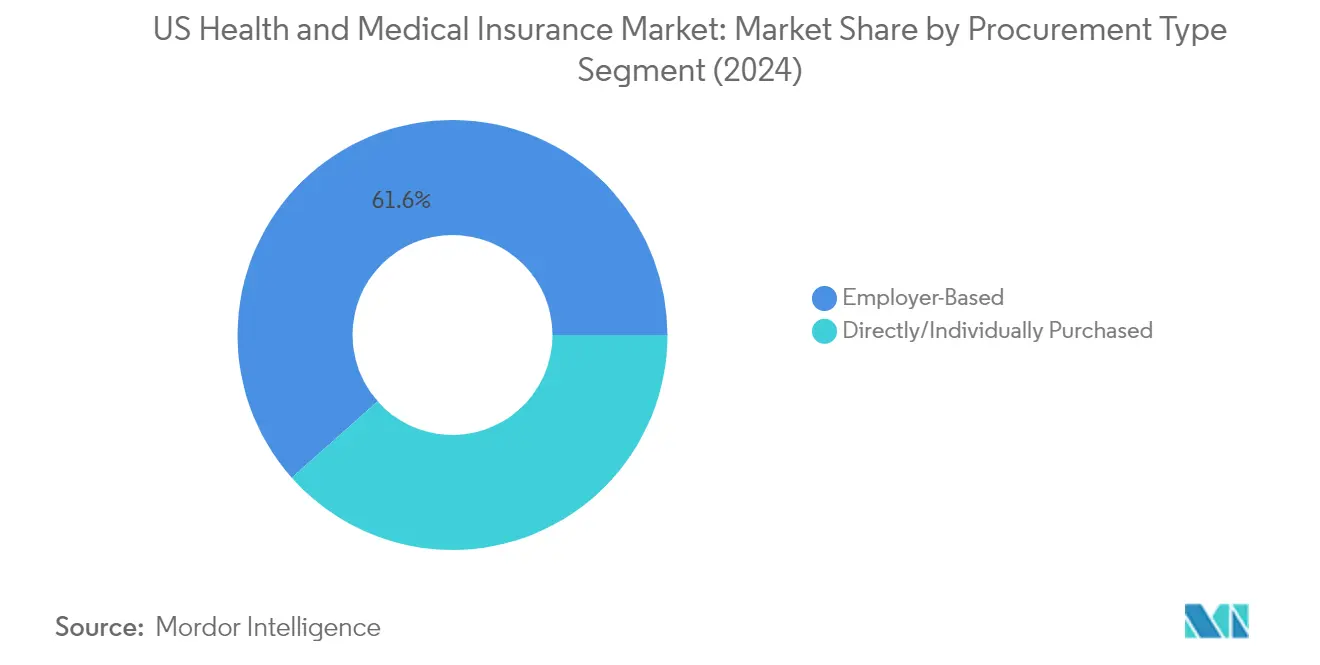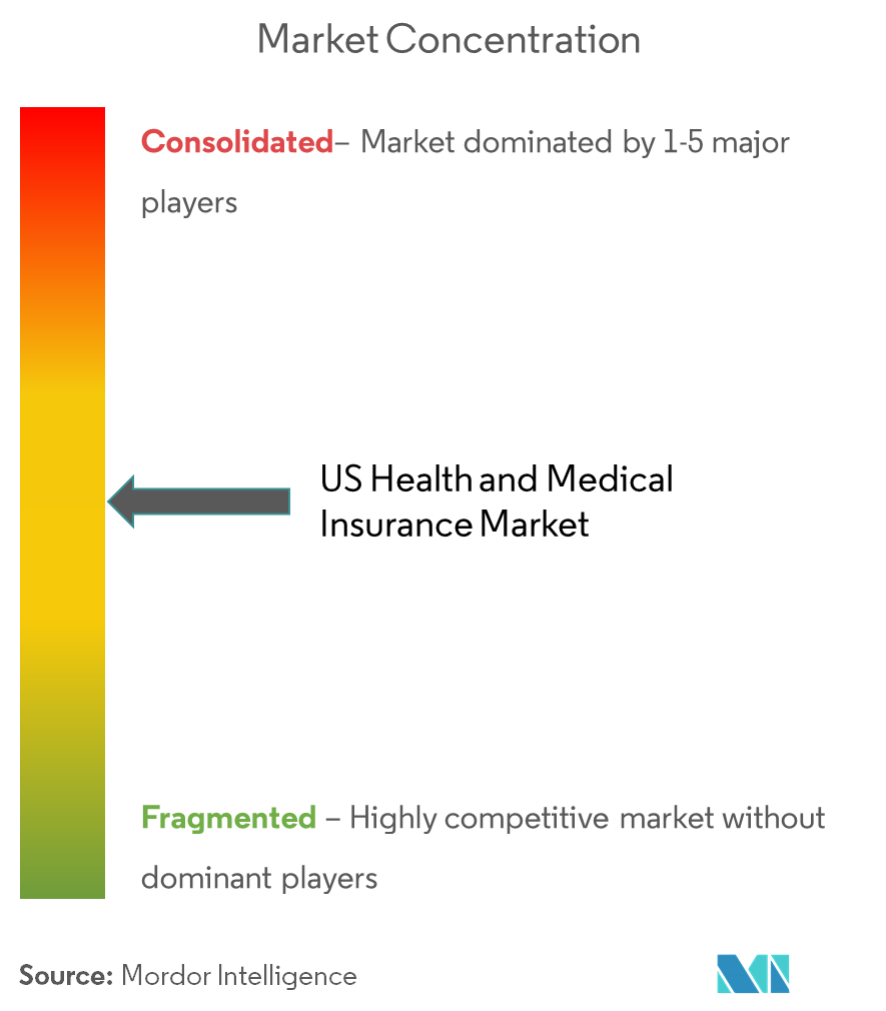
| Study Period | 2020 - 2030 |
| Base Year For Estimation | 2024 |
| Forecast Data Period | 2025 - 2030 |
| Market Size (2025) | USD 1.59 Trillion |
| Market Size (2030) | USD 2.13 Trillion |
| CAGR (2025 - 2030) | 6.00 % |
| Market Concentration | High |
Major Players
*Disclaimer: Major Players sorted in no particular order |
United States Health And Medical Insurance Market Analysis
The United States Health And Medical Insurance Market size is estimated at USD 1.59 trillion in 2025, and is expected to reach USD 2.13 trillion by 2030, at a CAGR of greater than 6% during the forecast period (2025-2030).
The United States health insurance landscape continues to evolve, characterized by a dual system of private health insurance and public health insurance coverage options. Private health insurance remains the dominant form of coverage, accounting for 66.5% of total coverage, while public coverage represents 34.8%. Employment-based insurance serves as the backbone of the healthcare system, covering 54.4% of the population, highlighting the crucial role employers play in providing healthcare insurance access. This structure has created a complex ecosystem where insurance providers must balance competitive pricing with comprehensive coverage options while navigating regulatory requirements and market demands.
The health insurance industry has experienced significant financial dynamics, with major insurers demonstrating robust performance and operational expansion. The industry witnessed a substantial increase in direct written premiums, reaching over USD 336 billion, with the top five insurance companies commanding nearly half of the total US market share. This concentration of market power has led to increased scrutiny of pricing practices and coverage policies, while also driving innovation in service delivery and customer engagement strategies. Administrative expenses have seen a notable rise, increasing by 32.6% to reach USD 84 billion, reflecting the growing complexity of healthcare management and regulatory compliance.
The market demonstrates a comprehensive coverage framework, with approximately 91.5% of Americans covered by various health insurance plans. This high coverage rate reflects the success of multiple initiatives and programs designed to expand access to healthcare services. The system operates through a sophisticated network of providers, with Medicare covering 18.4% of the population and Medicaid serving 17.8%, complementing the private health insurance sector. This multi-layered approach ensures diverse coverage options while presenting challenges in coordination and cost management.
The industry is witnessing a transformation in service delivery models and technological integration. Insurance providers are increasingly adopting digital platforms for policy management, claims processing, and customer service, leading to improved operational efficiency and enhanced user experience. The rise of telemedicine and virtual care services has prompted insurers to adapt their coverage policies and reimbursement models accordingly. This digital transformation is accompanied by a growing focus on preventive care and wellness programs, with insurers implementing innovative strategies to manage healthcare costs while improving patient outcomes through early intervention and lifestyle management programs.
United States Health And Medical Insurance Market Trends
Growing Utilization of Employer-Sponsored Health Insurance Programs
The employer-sponsored health insurance landscape continues to demonstrate robust growth, with employee benefits insurance being available to 71% of private industry workers and maintaining a significant 77% take-up rate among eligible employees. This high adoption rate is further reinforced by state and local government workers, where 89% have access to healthcare benefits with an impressive take-up rate of 88%. The comprehensive nature of these programs is evident in the additional benefits offered, with dental insurance benefits being available to 40% of private industry workers and 60% of state and local government workers, creating a more complete healthcare coverage ecosystem for employees.
The five states with the highest employer-sponsored coverage demonstrate the widespread adoption of these programs, with Illinois leading at 53% of the state population, followed by New York at 49%, Texas at 48%, and California covering 47% of its population through employer-sponsored plans. This extensive coverage is complemented by the availability of medical care benefits to 68% of non-union workers and 95% of union workers, with take-up rates of 65% and 81% respectively, indicating strong employee participation across different worker classifications. The growth in this sector is further supported by the increasing number of people employed in the Workers' Compensation and Other Insurance Funds industry, which has seen a 1.2% average increase over five years between 2017 and 2022.
Technological Integration and Digital Transformation
The digital health insurance market is experiencing a significant transformation through technological integration, with insurance companies increasingly leveraging artificial intelligence, chatbots, and machine learning to streamline their operations and enhance customer experience. AI technology is particularly revolutionary in enabling health insurers to collect, analyze, and utilize vast volumes of healthcare data for identifying new business opportunities and optimizing risk management. The integration of AI into insurance software has also proven crucial for enhancing medical billing processes while maintaining strict compliance with HIPAA regulations, demonstrating the dual benefit of improved efficiency and regulatory adherence.
The digital transformation is further accelerated by the widespread adoption of online insurance purchasing channels, driven by the increasing penetration of internet usage and smartphone accessibility. This shift is characterized by enhanced consumer confidence in online insurance purchases, supported by comprehensive guidance on discounts, offers, and plan selections provided through digital platforms. The convenience factor is amplified by the availability of a wide range of insurance products online, complemented by exclusive discounts and offers on insurance websites. This digital evolution is particularly evident in the changing consumer purchasing behavior, where the combination of technological advancement and user-friendly digital interfaces has created a more streamlined and accessible insurance acquisition process.
Rising Healthcare Costs and Chronic Disease Management
The escalating costs of healthcare treatments, particularly for chronic conditions such as diabetes, colorectal cancer, heart disease, and degenerative diseases, have become a significant driver for individual health insurance adoption in the United States. The financial burden associated with treating these chronic conditions has reached unprecedented levels, compelling individuals to seek comprehensive health insurance coverage to mitigate the risk of substantial out-of-pocket expenses. This trend is particularly notable in the private health insurance sector, where the increasing prevalence of chronic diseases is directly correlating with higher enrollment rates as individuals seek to protect themselves from potentially devastating medical costs.
The impact of rising healthcare costs is further evidenced by the evolving structure of private health insurance plans, which now typically involve a sophisticated combination of premiums, deductibles, co-payments, and co-insurance to provide comprehensive coverage while managing risk. These plans have expanded their scope to include a wide range of benefits and services, encompassing hospitalization, outpatient care, prescription drugs, preventive care, and mental health services, reflecting the growing complexity of healthcare needs. The affordability challenge remains significant for individuals who don't receive employer-sponsored coverage or qualify for government assistance programs, driving innovations in plan design and coverage options to address these accessibility concerns.
Segment Analysis: By Procurement Type
Employer-Based Segment in US Health and Medical Insurance Market
The employer-based segment continues to dominate the US health and medical insurance market, holding approximately 62% of the total market share in 2024. This substantial market presence is primarily driven by the comprehensive coverage options offered through both small and large group markets, making it the preferred choice for American workers. The segment's strength is reinforced by the extensive network of healthcare providers, competitive premium rates, and the ability to spread risk across larger pools of insured individuals. Employer-sponsored health insurance remains the backbone of the American healthcare system, with major insurance carriers developing specialized products and services tailored to meet the diverse needs of both small businesses and large corporations. The segment's robust performance is further supported by tax incentives for employers and the increasing adoption of value-based care models that help optimize healthcare costs while improving outcomes. Additionally, the inclusion of disability insurance and vision insurance within employer-based plans enhances the attractiveness of these offerings.

Directly/Individually Purchased Segment in US Health and Medical Insurance Market
The directly/individually purchased segment is projected to experience the highest growth rate of approximately 9% during the forecast period 2024-2029. This accelerated growth is being driven by the increasing demand for personalized healthcare coverage, the rise of the gig economy, and the growing number of self-employed professionals seeking flexible insurance options. The segment's expansion is further supported by technological advancements in digital insurance platforms, making it easier for individuals to compare, select, and manage their health insurance plans. Insurance providers are responding to this trend by developing innovative products that offer customizable coverage options, wellness programs, and integrated digital health solutions. The segment is also benefiting from improved consumer awareness about health insurance options and the continued evolution of online marketplace platforms that facilitate easy access to various insurance products, including supplemental health insurance and critical illness insurance.
Segment Analysis: By Product and Service Offered
High Deductible Health Plans Segment in US Health and Medical Insurance Market
High Deductible Health Plans (HDHPs) dominate the US health and medical insurance market, commanding approximately 65% market share in 2024. This significant market position is driven by employers increasingly adopting HDHPs as a cost-effective insurance option for their workforce. For 2024, the IRS defines an HDHP as any plan with a deductible of at least $1,400 for individuals or $2,800 for families, with total yearly out-of-pocket expenses capped at $7,050 for individuals and $14,100 for families. The segment's prominence is further strengthened by its integration with Health Savings Accounts (HSAs), offering tax advantages for qualified medical expenses. HDHPs particularly appeal to millennials and individuals who don't frequently utilize their insurance plans, as they benefit from lower monthly premiums despite higher deductibles.
Pharmacy Benefit Management Segment in US Health and Medical Insurance Market
The Pharmacy Benefit Management (PBM) segment is experiencing the most rapid growth in the US health and medical insurance market, with an expected growth rate of approximately 9% from 2024 to 2029. This accelerated growth is primarily driven by PBMs' crucial role in negotiating drug prices and managing prescription drug insurance benefits for health insurers, Medicare Part D plans, and major employers. The segment's expansion is further supported by the increasing focus on specialty drug management and the implementation of advanced technology solutions for better cost containment. The top three PBM companies - CVS Caremark, Express Scripts, and OptumRx - control approximately 89% of the market, serving about 270 million Americans, demonstrating the segment's consolidated yet dynamic nature.
Remaining Segments in Products and Services Offered
The remaining segments in the market include Managed Care Plans and Fee-for-Service Plans, each serving distinct healthcare needs. Managed Care Plans represent a significant portion of the market, offering structured healthcare delivery through networks of providers and emphasizing cost control and quality care through Health Maintenance Organizations (HMOs) and Preferred Provider Organizations (PPOs). Fee-for-Service Plans, while representing a smaller share, continue to provide flexibility in healthcare provider choice, particularly appealing to customers who prioritize provider freedom over cost savings. Both segments contribute to the market's diversity by offering different approaches to healthcare delivery and payment models, catering to varying consumer preferences and needs.
Segment Analysis: By Place of Purchase
Off Exchange/Marketplace Segment in US Health and Medical Insurance Market
The Off Exchange/Marketplace segment dominates the US health and medical insurance market, commanding approximately 74% of the total market share in 2024. This segment encompasses both ACA-compliant plans sold outside of the exchange and non-compliant plans that operate in separate risk pools. The primary distinction between on and off exchange ACA-compliant plans lies in the availability of subsidies, which are exclusively offered through the exchange platform. Off-exchange plans typically provide more flexibility in plan design and often feature a higher proportion of preferred-provider organization (PPO) or point-of-service (POS) plans, with more than 50% of off-exchange products being open plans. These plans particularly appeal to consumers who do not qualify for subsidies and prefer more diverse healthcare provider options, making them attractive to higher-income individuals and families seeking comprehensive coverage options.
On Exchange/Marketplace Segment in US Health and Medical Insurance Market
The On Exchange/Marketplace segment is experiencing the fastest growth in the US health and medical insurance market, with an expected growth rate of approximately 9% from 2024 to 2029. This robust growth is primarily driven by increasing adoption of digital platforms for insurance purchases and the expansion of government subsidies making health insurance more accessible to a broader population. The segment has shown particular strength in silver-level plans, with about 65% of on-exchange products being categorized as silver plans. The marketplace has evolved to become more consumer-friendly, offering streamlined enrollment processes and enhanced transparency in plan comparison. Additionally, the implementation of advanced digital tools and artificial intelligence has improved the customer experience, making it easier for consumers to navigate plan options and make informed decisions about their healthcare coverage.
United States Health And Medical Insurance Industry Overview
Top Companies in US Health and Medical Insurance Market
The US health insurance and medical insurance landscape is dominated by major players, including UnitedHealth Group, Anthem, Humana Group, Kaiser Permanente, and Centene Corporation. These industry leaders are increasingly focused on digital transformation through investments in telehealth platforms, artificial intelligence, and data analytics capabilities to enhance operational efficiency and customer experience. Companies are expanding their service portfolios through strategic acquisitions and partnerships, particularly in specialized areas like Medicare Advantage plans and managed care services. The industry is witnessing accelerated adoption of insurtech solutions, with companies developing mobile applications, implementing chatbots, and leveraging IoT devices for better risk assessment and personalized coverage options. Market leaders are also emphasizing value-based care models and preventive health programs while strengthening their provider networks through strategic collaborations with healthcare systems and clinics.
Consolidation and Strategic Growth Drive Market
The US commercial health insurance market exhibits high concentration levels with significant barriers to entry due to regulatory requirements, capital intensity, and the need for extensive provider networks. Market consolidation continues through strategic mergers and acquisitions, as evidenced by notable deals such as Centene's acquisition of WellCare Health Plans and Humana's acquisition of Kindred at Home. The industry structure favors large, established players who can leverage economies of scale, maintain robust technology infrastructure, and navigate complex regulatory environments across different states. These dominant insurers are increasingly expanding their vertical integration strategies by acquiring healthcare providers, pharmacy benefit managers, and technology companies to control costs and improve care coordination.
The competitive dynamics are characterized by a mix of national carriers and regional specialists, with larger players having significant advantages in terms of risk pool diversification and negotiating power with healthcare providers. Market leaders are strengthening their positions through strategic partnerships with technology companies and healthcare providers, while also investing in innovative care delivery models. The industry has seen increased participation from technology-focused new entrants, though their impact remains limited due to the established players' strong market positions and extensive distribution networks. Regional players maintain their relevance through specialized product offerings and strong local provider relationships.
Innovation and Adaptability Key to Success
Success in the healthcare insurance market increasingly depends on companies' ability to leverage technology for operational efficiency and enhanced customer experience. Insurers must focus on developing comprehensive digital platforms that integrate various healthcare services while maintaining strong relationships with provider networks. The ability to analyze and utilize health data for personalized coverage options and risk assessment has become crucial for maintaining competitive advantage. Companies need to balance innovation with regulatory compliance while addressing growing consumer demands for transparency and value-based care models. Market leaders are investing in preventive care programs and wellness initiatives to manage costs and improve outcomes.
Future market success will require insurers to adapt to evolving regulatory requirements, particularly regarding coverage mandates and pricing transparency. Companies must develop strategies to address the growing influence of government-sponsored programs while maintaining profitability in commercial segments. The increasing focus on social determinants of health and population health management necessitates new approaches to risk assessment and care delivery. Successful players will need to maintain strong capital positions while investing in technology infrastructure and innovative care models. The ability to forge strategic partnerships with healthcare providers and technology companies while maintaining cost efficiency will be crucial for long-term success in this dynamic market.
United States Health And Medical Insurance Market Leaders
-
UnitedHealth Group
-
HCSC Group
-
Centene Corporation
-
Elevance Health
-
Cigna Group
- *Disclaimer: Major Players sorted in no particular order

United States Health And Medical Insurance Market News
- January 2024: HCSC entered into a binding contract with The Cigna Group to purchase its Medicare Advantage, Medicare Supplemental Benefits, Medicare Part D, and CareAllies businesses. This acquisition will bring significant advantages to HCSC's existing and prospective members, as it will strengthen the company's capabilities and expand its presence, especially in the expanding Medicare sector.
- January 2024: Elevance Health announced its plans to acquire Paragon Healthcare Inc., a well-known company specializing in delivering vital infusible and injectable therapies that enhance and preserve lives.
United States Health And Medical Insurance Market Report - Table of Contents
1. INTRODUCTION
- 1.1 Study Assumptions and Market Definition
- 1.2 Scope of the Study
2. RESEARCH METHODOLOGY
3. EXECUTIVE SUMMARY
4. MARKET DYNAMICS
- 4.1 Market Overview
-
4.2 Market Drivers
- 4.2.1 Government Subsidized Health Insurance Schemes is Boosting the Sales of Health and Medical Insurance Policies
- 4.2.2 Aging Population in United States and increasing Healthcare Costs
-
4.3 Market Restraints
- 4.3.1 Rising Costs and Limited Coverage
- 4.3.2 Increasing Regulatory complexity
-
4.4 Market Opportunities
- 4.4.1 Innovative Digital Health Solutions
- 4.4.2 Merger and Acquisition with the Companies
-
4.5 Porter's Five Forces Analysis
- 4.5.1 Threat of New Entrants
- 4.5.2 Bargaining Power of Buyers/Consumers
- 4.5.3 Bargaining Power of Suppliers
- 4.5.4 Threat of Substitute Products
- 4.5.5 Intensity of Competitive Rivalry
-
4.6 Government Regulations and Initiatives
- 4.6.1 Brief on Patient Protection and Affordable Care Act (ACA) and its implications on the Overall Health Insurance Coverage
- 4.6.2 Insights on Latest Healthcare Policy Changes and their Effect on the Health Spending by US Citizens
- 4.7 Brief on Health Insurance Premiums and Study on the Effect of Medical Trend Rate on Health Plans
- 4.8 Insights on the Growing Online Sales of Health Insurance and the Growth Prospects in Health Insurance Sector
- 4.9 Technological Advancement and Innovation in Health Insurance Sector
- 4.10 The Impact of the COVID-19 Pandemic on the US health Insurance market
5. MARKET SEGMENTATION
-
5.1 By Procurement Type
- 5.1.1 Directly/individually Purchased
- 5.1.2 Employer-Based
- 5.1.2.1 Small Group Market
- 5.1.2.2 Large Group Market
-
5.2 By Products and Services Offered
- 5.2.1 Pharmacy Benefit Management
- 5.2.2 High Deductible Health Plans
- 5.2.3 Free-For-Service Plans
- 5.2.4 Managed Care Plans
-
5.3 By Place of Purchase
- 5.3.1 On Exchange
- 5.3.2 Off Exchange
6. COMPETITIVE LANDSCAPE
- 6.1 Market Concentration Overview
-
6.2 Company Profiles
- 6.2.1 UnitedHealth Group
- 6.2.2 Elevance Health
- 6.2.3 Cigna Group
- 6.2.4 HealthCare Services Group Inc.
- 6.2.5 Centene Corporation
- 6.2.6 Aetna Inc.
- 6.2.7 Kaiser Foundation Group
- 6.2.8 Independence Health Group
- 6.2.9 Molina Healthcare
- 6.2.10 Guidewell Mutual Holding
- 6.2.11 Humana
- 6.2.12 CVS Health*
- *List Not Exhaustive
7. FUTURE MARKET TRENDS
8. DISCLAIMER AND ABOUT US
United States Health And Medical Insurance Industry Segmentation
Health insurance is a type of insurance that covers medical expenses that arise due to an illness. A complete background analysis of the US Health Insurance industry, including an assessment of the national health accounts, economy, and emerging market trends by segments, significant changes in market dynamics, and market overview, is covered in the report. The market is segmented by procurement type, products and services, and place of purchase. By procurement type, the market is segmented as directly purchased and employer-sponsored. By products and services, the market is segmented into pharmacy benefit management, high-deductible health plans, free-for-service plans, and managed care plans. By place of purchase, the market is segmented as on exchange and off exchange. The report offers market size forecasts for the US health insurance market in terms of revenue (USD) for all the above segments.
| By Procurement Type | Directly/individually Purchased | ||
| Employer-Based | Small Group Market | ||
| Large Group Market | |||
| By Products and Services Offered | Pharmacy Benefit Management | ||
| High Deductible Health Plans | |||
| Free-For-Service Plans | |||
| Managed Care Plans | |||
| By Place of Purchase | On Exchange | ||
| Off Exchange | |||
United States Health And Medical Insurance Market Research Faqs
How big is the United States Health And Medical Insurance Market?
The United States Health And Medical Insurance Market size is expected to reach USD 1.59 trillion in 2025 and grow at a CAGR of greater than 6% to reach USD 2.13 trillion by 2030.
What is the current United States Health And Medical Insurance Market size?
In 2025, the United States Health And Medical Insurance Market size is expected to reach USD 1.59 trillion.
Who are the key players in United States Health And Medical Insurance Market?
UnitedHealth Group, HCSC Group, Centene Corporation, Elevance Health and Cigna Group are the major companies operating in the United States Health And Medical Insurance Market.
What years does this United States Health And Medical Insurance Market cover, and what was the market size in 2024?
In 2024, the United States Health And Medical Insurance Market size was estimated at USD 1.49 trillion. The report covers the United States Health And Medical Insurance Market historical market size for years: 2020, 2021, 2022, 2023 and 2024. The report also forecasts the United States Health And Medical Insurance Market size for years: 2025, 2026, 2027, 2028, 2029 and 2030.
Our Best Selling Reports
United States Health And Medical Insurance Market Research
Mordor Intelligence provides a comprehensive analysis of the health and medical insurance industry. We leverage extensive expertise in healthcare insurance research and consulting. Our detailed examination covers all major segments, including medicare, medicaid, private health insurance, and public health insurance sectors. The report offers in-depth insights into dental insurance, vision insurance, and critical illness insurance markets. Additionally, it analyzes trends in managed care systems and the implementation of universal healthcare.
Stakeholders across the industry, from providers of individual health insurance to commercial health insurance companies, benefit from our actionable intelligence. This information is available in an easy-to-download report PDF format. The analysis includes group health insurance, supplemental health insurance, and disability insurance segments. It also explores emerging trends in digital health insurance solutions. Our research covers prescription drug insurance, personal accident insurance, and employee benefits insurance, providing valuable insights for decision-makers in both traditional and innovative insurance models.




